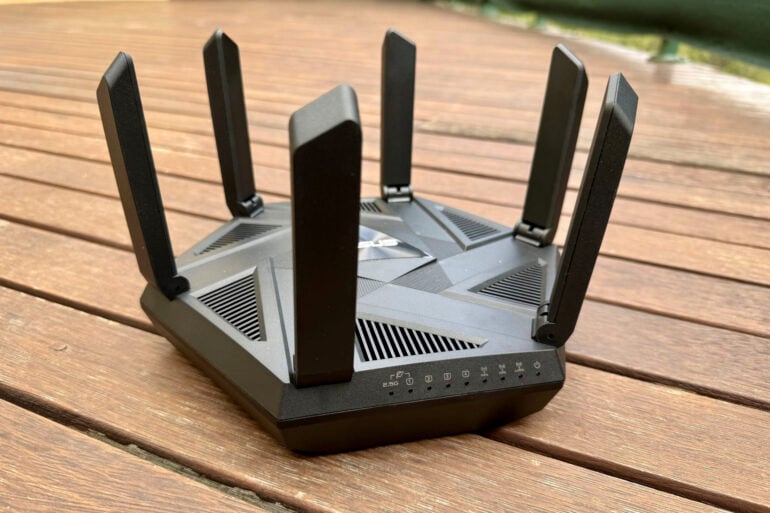
Embracing the 6 GHz band for a short-range speed boost, the Wi-Fi 6E-capable Asus RT-AXE7800 wireless router is a stepping stone for those homes not ready to make the leap to Wi-Fi 7.
These days, Wi-Fi 7 makes the headlines, but if you don’t need the latest and greatest, older Wi-Fi 6E routers like the Asus RT-AXE7800 still have a lot to offer.
Compared to Wi-Fi 6, the Wi-Fi 6E standard adds support for the 6 GHz band to deliver faster speeds than 5 GHz, but over short distances. Wi-Fi 6 also supports more extra-wide 80 MHz and 160 MHz channels, so you can squeeze through more data.
With the $489 Asus RT-AXE7800, you get the benefit of tri-band 2.4, 5 and 6 GHz networking, plus a few fancy tricks to help your wireless network extend to the farthest reaches of your home.
Keep in mind Wi-Fi 7 routers like the $529 Asus RT-BE92U are becoming more affordable, so it’s worth weighing it up against the RT-AXE7800 to see which is the best fit for your home and budget.
Table of contents
- First impressions
- Specifications and price
- Features
- Quality
- Who is the Asus RT-AXE7800 wireless router for?
First impressions
The Asus RT-AXE7800 wireless router is an unusual hexagon shape but sticks with the “dead spider” design, with six antennas that fold up but don’t swivel.
It’s a common look with gaming routers focused on performance, even though the RT-AXE7800 is not part of the high-end ROG and Asus gaming router ranges.
While the RT-AXE7800 looks striking, it’s a bit of an awkward size and shape, which might make it difficult to place in a convenient location where it can provide good Wi-Fi coverage. Thankfully, it also features mounting holes for attaching it to the wall.
Using the Asus logo on the top to determine the front edge, you find a row of status lights. The upside is that they’re small and subtle, the downside is that they’re difficult to interpret from a distance – unlike the large multi-coloured status lights on the likes of Netgear’s Orbi routers.
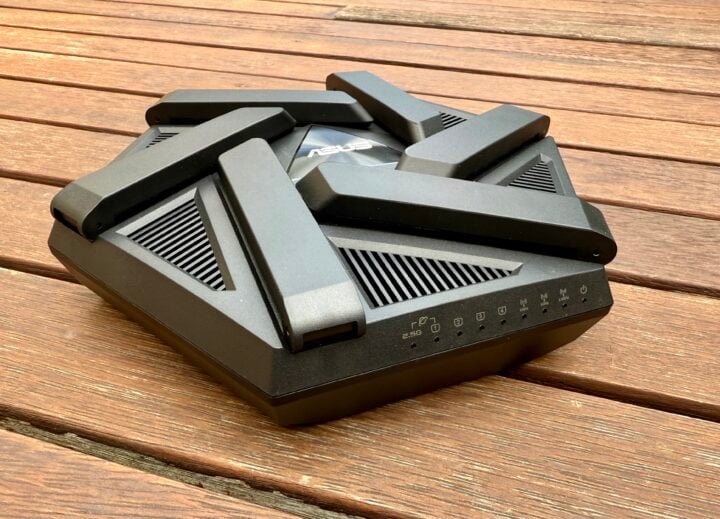
Meanwhile, the recess at the back of the router features 2.5 Gbps and 1 Gbps WAN/LAN ports, with support for WAN and LAN aggregation. You’ll also find three 1 Gbps LAN ports for connecting to wired devices and Ethernet switches around your home.
You miss out on the 10 Gbps WAN and multiple 2.5 Gbps LAN ports on more advanced routers, but that might not matter if you don’t have the broadband connection and home networking gear to make the most of the faster speeds.
This would be part of the reason why the RT-AXE7800 only features a 1.7 GHz processor and 512 MB of RAM, whereas more advanced routers tend to pack more grunt to underpin their high-end performance.
Finally, there’s a USB3.0 port on the back which can connect to a printer, attached storage or a mobile broadband dongle for 4G fallback.
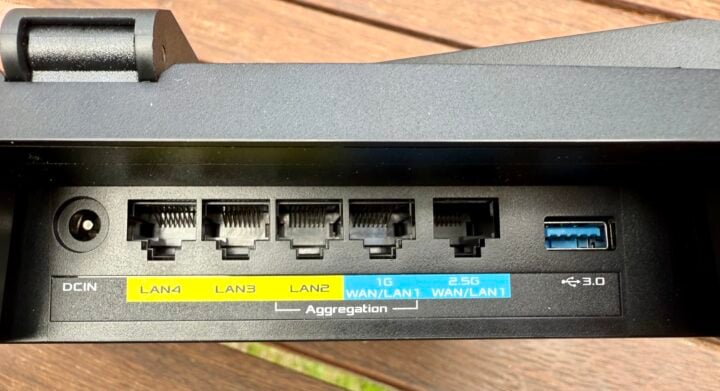
Surprisingly, the power and reset buttons are on the bottom of the router, making them difficult to reach – especially if the router is installed up high. The WPS (Wi-Fi Protected Setup) button for easily connecting Wi-Fi devices is also on the bottom, which, once again, is far from convenient.
As a tri-band router, the RT-AXE7800 generates standard 2.4 GHz (up to 574 Mbps) and 5 GHz (up to 4804 Mbps) networks. Plus, there’s an extra 6 GHz band for connecting compatible Wi-Fi 6E and Wi-Fi 7 devices. In theory, 6 GHz can transmit data faster than 5 GHz over short distances, but it’s only rated up to 2042 Mbps here because it doesn’t use as many antennas as the 5 GHz network.
All of this combined gives the router a maximum wireless throughput of 7240 Mbps, but of course, you’re not going to see this in real-world conditions.
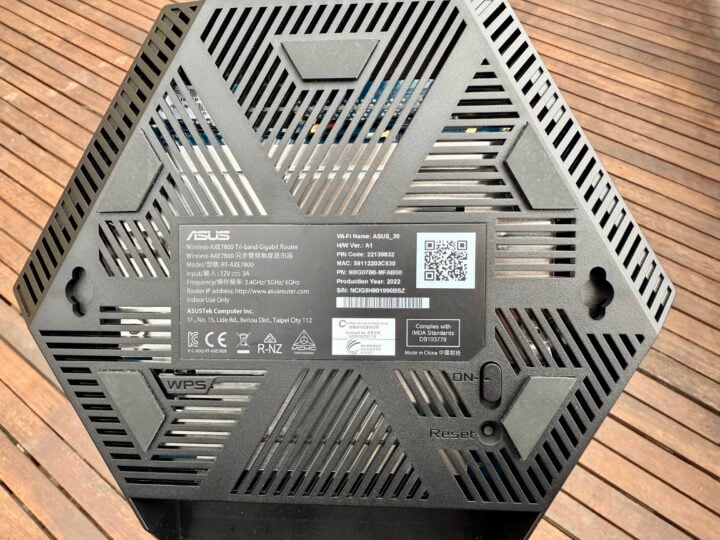
It’s worth mentioning that, as a Wi-Fi 6E router, you miss out on Wi-Fi 7’s wider 320 MHz channels. You also miss out on Multi-Link Operation (MLO), which allows some Wi-Fi 7-compatible devices to connect to the 2.4, 5 and 6 GHz bands simultaneously and switch between them on the fly.
Asus RT-AXE7800 specifications and price
| Wi-Fi | Wi-Fi 6E 802.11 ax/ac/n/a/b/g |
| Bands | Tri band: AXE7800 574+4804+2402 Mbps 2.4, 5, 6 GHz Up to 160 MHz channels |
| Bandwidth management | 2.4GHz 2×2 MU-MIMO 5GHz 4×4 MU-MIMO 6GHz 2×2 MU-MIMO Beamforming OFDMA 1024-QAM high data rate |
| Antenna | External antenna x 6 |
| Ethernet | 2.5 Gigabit LAN/WAN x 1 Gigabit LAN/WAN x 1 Gigabit LAN x 3 |
| USB3.2 Gen 1 | USB3.2 Gen 1 |
| Processor | 1.7 GHz quad-core processor |
| Memory | 256 MB Flash and 512 MB DDR4 RAM |
| Dimensions | 243 x 223 x155 mm |
| Weight | 1.033 kg |
| Price | $599 RRP (selling for $489) |
| Warranty | 3 years |
| Official website | Asus Australia |
Features
Like many modern wireless routers, the Asus RT-AXE7800 supports “mesh” networking to improve coverage. This means the wireless router can act as a central hub, working in unison with satellite hubs spread around your house.
Unlike more expensive options such as the Netgear Orbi 970 mesh Wi-Fi 7, Amazon Eero Max 7 and Asus ZenWiFi BQ16, the Asus RT-AXE7800 doesn’t come with mesh satellite hubs included. Asus doesn’t sell dedicated satellite hubs; instead, its AiMesh Extendable Network technology supports using most other Asus routers as mesh satellites.
It’s worth noting that, when in mesh mode, the RT-AXE7800 doesn’t generate an extra hidden band for dedicated wireless backhaul. It’s a trick employed by more expensive routers, allowing the router and satellite hubs to talk amongst themselves for improved traffic routing.
Asus also keeps the price down by limiting the RT-AXE7800’s antennas and MU-MIMO (Multi-User Multiple-Input Multiple-Output) capabilities, which take advantage of multiple antennas to help battle wireless congestion.
The RT-AXE7800 offers 2×2 MU-MIMO on the 2.4 GHz and 6 GHz bands, increasing to 4×4 MU-MIMO on the 5 GHz bands, which is likely to be doing the heavy lifting. While this is surprisingly better than the Wi-Fi 7-capable Asus RT-BE92U (which only offers 2.4 GHz 3×3, 5 GHz 2×2 and 6 GHz 2×2), more expensive routers tend to increase this to 4×4 MU-MIMO on every band, which significantly increases both their speed potential and how they hold up under heavy load.
With the RT-AXE7800, you do have the benefit of “beamforming”, which allows the router to focus its wireless signals on compatible devices that are struggling to maintain a strong connection. It doesn’t make much of a difference up close, but beamforming becomes more effective in challenging conditions over long distances.
When it comes to setting up the Asus RT-AXE7800, you can use the Asus Router app or connect to the router’s admin interface using a browser. There’s a good initial setup wizard to help you get connected to the internet and set up your local wired and wireless networks.
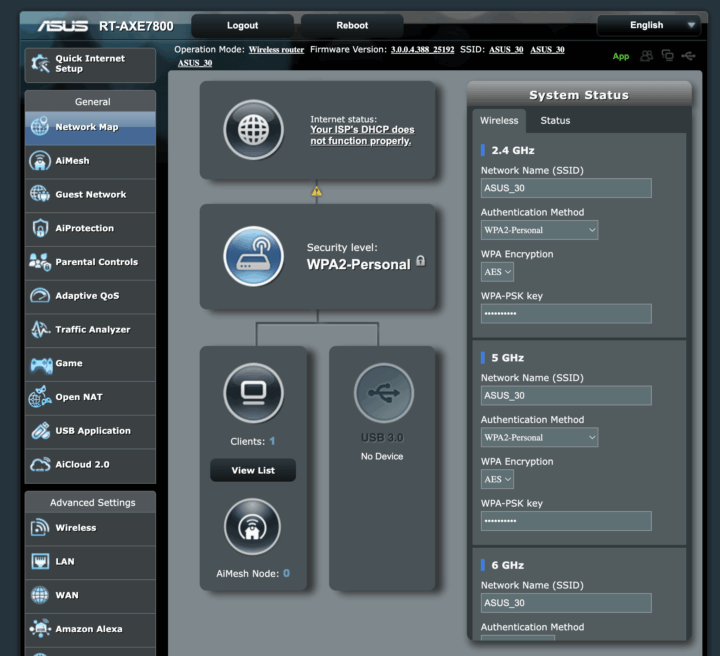
You’ve got plenty of free software-based features at your disposal, some of which other brands only offer at a price.
When it comes to security, Asus’ AiProtection Pro (powered by Trend Micro) offers malicious site blocking, infected device prevention and blocking, and an intrusion prevention system. Plus, it offers comprehensive VPN client/server features for secure remote connections.
Parental controls include safe browsing, which relies on lightweight configurable DNS-based filtering rather than running software on end devices. This way, the filtering applies to all devices connected to your network, such as game consoles.
Parents also get the ability to block access to unwanted websites and apps, along with internet scheduling for enforcing a time-out.
Quality
To put the Asus RT-AXE7800 wireless router to the test, I turned to a Wi-Fi 6E-capable Lenovo notebook. As a comparison, I ran the same tests with the primary hub of a Netgear Orbi 760 wireless mesh network, which only supports Wi-Fi 6.
At a range of 3 metres from the Wi-Fi 6E Asus router, the Lenovo notebook achieved speeds of 880 Mbps on the 6 GHz band using 160 MHz channels. It was transferring a 2.5 GB disc ISO, coming via FTP from my Synology Network Attached Storage drive, across my gigabit Ethernet LAN to the router and then wirelessly from the router to the notebook.
In comparison, the Wi-Fi 6 Netgear router could only deliver 824 Mbps over 5 GHz 80 MHz channels. So 6 GHz wins out, but that’s not the whole story.
I know from previous Wi-Fi 7 tests that 880 Mbps is about the speed limit of my home gigabit Ethernet network when connecting to the Synology NAS downstairs in my office via a few gigabit Ethernet switches.
To give Wi-Fi 6E a chance to really stretch its legs, I plugged my MacBook Pro directly into the back of the Asus router using a 2.5 Gbps Ethernet to USB-C adapter (which required dipping into the router’s settings to make the 2.5 Gbps port a LAN port).
Then I transferred files between the wireless Lenovo notebook and the wired MacBook Pro. With the bottleneck removed, the Asus RT-AXE7800 hit an impressive 1032 Mbps on Wi-Fi 6E (6 GHz, 160 MHz channels). It’s a big step up from the Netgear router’s 824 Mbps on Wi-Fi 6 (5 GHz, 80 MHz), but nowhere near as impressive as the 1824 Mbps (6 GHz, 320 MHz) achieved when testing the Asus RT-BE92U Wi-Fi 7 router earlier this year.
It’s no surprise 6 GHz can clearly deliver the goods when you get up close and personal, but I wanted to see how it would cope with some distance.
In the next room, 9 metres away, the Wi-Fi 6E Asus router still hit 824 Mbps on 6 GHz, whereas the Wi-Fi 6 Netgear router could only muster 696 Mbps on 5 GHz.
At a range of 15 Mbps, down a flight of stairs, the Wi-Fi 6E Asus router managed 400 Mbps on 6 GHz, but struggled to stay connected. Switching over to 5 GHz, the Wi-Fi 6E Asus router comfortably hit 600 Mbps. Meanwhile, the Wi-Fi 6 Netgear could only squeeze out 80 Mbps at this range (to be fair, the Netgear router is designed to be part of a three-hub mesh, so at that range you’d hopefully be closer to one of the other hubs).
To be honest, I was expecting that 6 GHz would struggle to outgun 5 GHz from the next room, so it was impressive seeing 6 GHz deliver the goods at a decent range.
Who is the Asus RT-AXE7800 wireless router for?
If your devices can make the most of the 6 GHz band, then the Asus RT-AXE7800 will certainly deliver a speed boost to homes still relying on a Wi-Fi 6 or earlier router.
That said, the RT-AXE7800 is the awkward middle child of the Asus router line-up, seemingly Asus’ only Wi-Fi 6E router wedged between a wide range of Wi-Fi 6 and Wi-Fi 7 models. As such, it’s hard to get too excited about the $489 Asus RT-AXE7800 when it’s less than $50 to set up one of Asus’ Wi-Fi 7 routers.
The post Asus RT-AXE7800 wireless router review: Band together appeared first on GadgetGuy.



0 (mga) komento:
Mag-post ng isang Komento